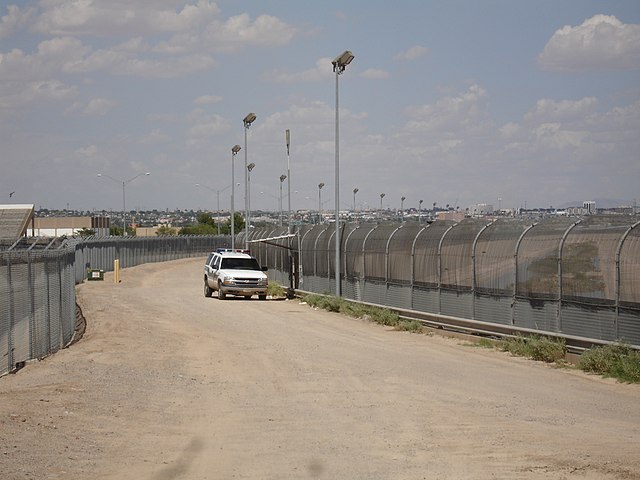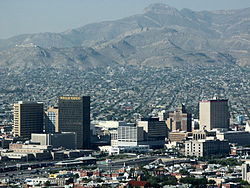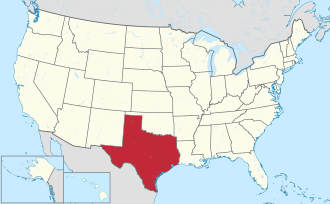Top Qs
Timeline
Chat
Perspective
El Paso County, Texas
County in Texas, United States From Wikipedia, the free encyclopedia
Remove ads
El Paso County is the westernmost county in the U.S. state of Texas. As of the 2020 census, the population was 865,657,[1] making it the ninth-most populous county in the state of Texas. Its county seat is the city of El Paso,[2] the sixth-most populous city in Texas and the 22nd-most populous city in the United States. The county was created in 1850 and later organized in 1871.[3]
Remove ads
El Paso is short for "El Paso del Norte", which is Spanish for "The Route of the North". It is named for the pass the Rio Grande creates through the mountains on either side of the river. The county is northeast of the Mexico–United States border.
El Paso County is included in the El Paso metropolitan area. Along with Hudspeth County, it is one of two counties of Texas entirely in the Mountain Time Zone (all other Texas counties except for northwestern Culberson County use Central Time). El Paso County is one of nine counties that comprise the Trans-Pecos region of West Texas.
Remove ads
Geography

According to the U.S. Census Bureau, the county has a total area of 1,015 square miles (2,630 km2), of which 1,013 square miles (2,620 km2) is land and 2.3 square miles (6.0 km2) (0.2%) is water.[4][5][6][7][8][9]
Adjacent counties and municipalities
- Doña Ana County, New Mexico – northwest
- Otero County, New Mexico – northeast
- Hudspeth County – east
- Guadalupe, Chihuahua, Mexico – south
- Juárez, Chihuahua, Mexico – south
- Práxedis G. Guerrero, Chihuahua, Mexico – southeast
National protected area
Major highways
Remove ads
Demographics
Summarize
Perspective
As of the 2010 United States census, there were 800,647 people living in the county. 82.1% were White of largely Hispanic descent, 10.5% of other races, 3.1% African American or Black, 2.5% of two or more races, 1.0% Asian, 0.8% Native American and 0.1% Pacific Islander. 82.2% were Latino (of any race).
As of the census[17] of 2000, there were 679,622 people, 210,022 households, and 166,127 families living in the county. The population density was 671 people per square mile (259 people/km2). There were 224,447 housing units at an average density of 222 per square mile (86/km2). The city was 78.23% Latino of any race. The racial makeup of the county was 73.95% White, 17.91% from other races, 3.06% African American or Black, 0.82% Native American, 0.98% Asian, 0.10% Pacific Islander, and 3.19% from two or more races.
There were 210,022 households, out of which 44.90% had children under the age of 18 living with them, 56.70% were married couples living together, 18.00% had a female householder with no husband present, and 20.90% were non-families. 17.80% of all households were made up of individuals, and 6.70% had someone living alone who was 65 years of age or older. The average household size was 3.18 and the average family size was 3.63.
In the county, the population was spread out, with 32.00% under the age of 18, 10.60% from 18 to 24, 29.30% from 25 to 44, 18.40% from 45 to 64, and 9.70% who were 65 years of age or older. The median age was 30 years. For every 100 females there were 93.20 males. For every 100 females age 18 and over, there were 88.70 males.
The median income for a household in the county was $31,051, and the median income for a family was $33,410. Males had a median income of $26,882 versus $20,722 for females. The per capita income for the county was $13,421. About 20.50% of families and 23.80% of the population were below the poverty line, including 31.50% of those under age 18 and 18.50% of those age 65 or over.
Remove ads
Government and Politics
Summarize
Perspective
Most of El Paso County is included in the 16th Congressional District in the U.S. House, represented by Democrat Veronica Escobar. A small eastern portion of the county is in the 23rd Congressional District, represented since 2021 by Republican Tony Gonzales. El Paso County is historically Democratic and the 2008 presidential election was no exception. Democrat Barack Obama won 66% of the vote with 121,589 votes even though he lost the entire state of Texas by about 946,000 votes. Republican John McCain won 33% of the vote in El Paso County with 61,598 votes. Other candidates won 1% of the vote. In 2004, Democrat John F. Kerry won El Paso County but by a smaller margin than Barack Obama. John Kerry won 56% of the vote, while Republican and former Governor of Texas George W. Bush won 43% of the vote with 73,261 votes.
In 2024 Donald Trump got the biggest vote share for a Republican in the county since 2004 with 41.8%, constituting a 20 point shift margin-wise to the right from 2020.[18] This was largely due to increased support for Trump among Latinos, whom he won in Texas with 54%.[19]
The El Paso County Sheriff's Office is headquartered in an unincorporated area in El Paso County.[22] At one point it was headquartered within the City of El Paso.[23] The Leo Samaniego Law Enforcement Complex is adjacent to the sheriff's office headquarters.[24]
Like all Texas counties, El Paso County is governed by a Commissioners Court, which consists of a County Judge, who is elected county-wide, and four County Commissioners, who represent individual precincts.[25] While the County Judge possesses some traditional powers of a judge, the County Judge functions primarily as the chief executive of the county. The County Judge presides over Commissioners Court meetings, casts one vote on Commissioners Court (as do County Commissioners), and lacks veto authority.
The El Paso County Judge is Ricardo Samaniego, and the county commissioners are Carlos Leon (Precinct 1), David Stout (Precinct 2), Iliana Holguin (Precinct 3),[26] and Carl L. Robinson(Precinct 4). The commissioners and the county judge are all Democrats.
Vogt was appointed County Judge in October 2017 by the County Commissioners, following County Judge Veronica Escobar's resignation to run for Congress. He was previously Escobar's chief of staff. He will serve the remainder of her term, through the end of 2018.[27] Leon and Perez were first elected to their positions in 2012, were re-elected in 2016,[28] and have been in office since 2013. Haggerty and Stout were first elected to their positions in 2014, and have been in office since 2015.[29]
The first woman to hold elected office in El Paso County was a teacher, Myra Carroll Winkler, who was elected as superintendent of El Paso County schools in 1912.[30][31]
United States Congress
Texas Legislature
Texas Senate
Texas House of Representatives
County government
El Paso County elected officials
Remove ads
Communities
Cities
Towns
Village
Census-designated places
Military Base
Unincorporated communities
Economy
As of 2021, El Paso County had a total GDP of around $30 billion and $35,000 per capita.[32]
Education
School districts include:[33]
- Anthony Independent School District
- Canutillo Independent School District
- Clint Independent School District
- El Paso Independent School District
- Fabens Independent School District
- San Elizario Independent School District
- Socorro Independent School District
- Tornillo Independent School District
- Ysleta Independent School District
All of the county is in the service area of El Paso Community College.[34]
Remove ads
National Historic Landmark
The Rio Vista Bracero Reception Center was designated It was named a National Historic Landmark by the U.S. Secretary of the Interior, Deb Haaland, on December 11, 2023. The Rio Vista Farm buildings and surrounding fields in Socorro, TX are included in the Historic Landmark district.[35]
See also
References
External links
Wikiwand - on
Seamless Wikipedia browsing. On steroids.
Remove ads





